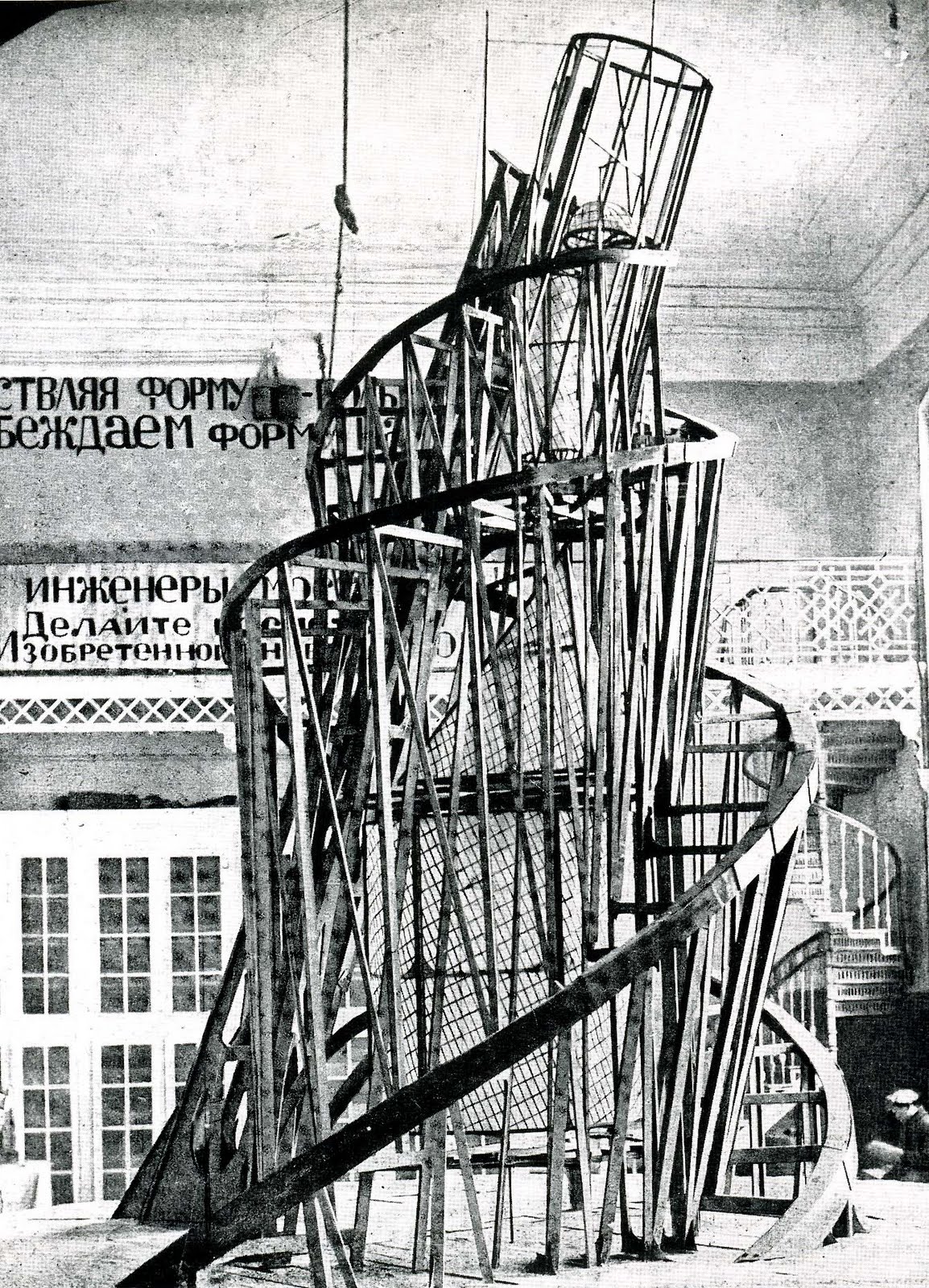Avant-Garde
Betsy Balch

Figure 1. Vladimir Tatlin, Model of Monument to the Third International (1919). Current location unknown.
An avant-garde project pushes the visual and conceptual boundaries of what is considered art and advocates for a broader social role for the artist.1 Avant-garde is a French military term meaning “before the guard” and refers to those on the front lines in battle. When applied to artists, it imagines them as cultural soldiers, forerunners in the development of new ideas.
Although historically the avant-garde has adopted many forms and functions, the praxis of these artists usually involves an explicit social or political critique, embedded in works whose radical stylistic and technical elements challenge conventions of the canon. The historical avant-garde of the early twentieth century includes multiple movements such as Cubism, Futurism, Dadaism, and Constructivism. Peter Bürger has theorized that the artistic avant-garde promotes process over content and integrates art into everyday life to encourage the transformation of society, breaking down adherence to “the institution of art.” 2
Russian Constructivism is seen by many scholars as the epitome of avant-garde art, in its visual fracturing of form, its use of contemporary materials and technology, and its politically motivated insistence on the artist’s role as a constructor rather than as fine artist. The movement was notable for its utopian ideal—a complete integration of art and life–in a post-Revolution Soviet society.3 Visually, Constructivist work is identified by abstract, geometric forms and the use of various materials which are “assembled rather than carved or modeled.”4 The leading Constructivists (Tatlin, Rodchenko, Popova, Stepanova) stressed their work as “production” and moved away from a focus on an individual, subjective style.5 These artists attempted to make abstract art into meaningful and practical designs, which would have a broader social utility for the collective.6
Vladimir Tatlin’s maquette for the Monument to the Third International (1919) speaks directly to the many avant-garde goals of Russian Constructivism [Figure 1]. Though the monument was never executed full-scale, it was intended to be the Propaganda Center for the Communist Third International, the organization devoted to spreading Communist ideals beyond Russia. It is sometimes referred to as “Tatlin’s cathedral to socialism,” which speaks to its goal of engaging viewers politically, which is essential to the avant-garde.7 The monument was designed to be built from a metal frame that spiraled up at a diagonal, the axis of which would point to the North Star. This was meant to indicate that even the heavens would rotate around the building and, inherently, the larger communist organization, whose aspirations would continue to ascend like the helical structure itself.8
The monument would be made from an iron armature, within which four glass structures were aligned, to serve as meeting spaces. Art historian Margit Rowell describes these meeting spaces in the following way:
The lowest, a broad based cylinder, was designed for annual meetings of the legislative body, and was to revolve once a year. The second, a pyramid, would house monthly executive meetings and revolve once a month. The two uppermost chambers, a narrow cylinder and a hemisphere, would serve respectively as an information bureau and to emit propaganda to the street. The cylinder was to revolve once a day, the hemisphere, hourly.9
The use of glass and iron was seen as a nod to new age technology and industry. Tatlin believed that the inherent nature of materials must be stressed in the construction of a work, a concept the Russians referred to as faktura.10 For this reason, he chose glass which “inscribes or defines space without closing off, thus allowing interaction between inner and outer spaces (in this case between the representatives of the people and the people themselves.)”11
Conceptualized in 1919 at the close of the first World War and soon after the Russian Revolution of 1917, the Monument represents a high point in Tatlin’s belief that he could enact some sort of social change through his work. Bürger notes:
The radicality of the avant-garde critique of the existing order is the result of an unbroken confidence in the possibility of living without anxiety and restructuring social reality. Wherever this confidence…is lost, whenever the future is darkened, the avant-gardes enter a zone of extreme peril.12
For lack of funds, Tatlin’s monument was never constructed. Eventually, Stalin chose the more naturalistic style of Socialist Realism as the official art of the Soviet Union, since its glorification of communist values was more accessible.13 Tatlin, presumably, lost the confidence that Bürger identified as pivotal to the radicality of his critique. Avant-gardism tests the boundaries of art and, in turn, larger societal ideas; the artist becomes the vanguard of social and institutional critique. Whether they succeed in their goals or not, this concept has led to some of the most iconic and intriguing works in the history of art.
Footnotes
- Peter Bürger, “Avant-Garde,” Encyclopedia of Aesthetics, Oxford Art Online, Oxford University Press.
- Peter Bürger, Theory of the Avant-Garde, trans. Michael Shaw (Minneapolis: University of Minnesota Press, 1984), 26.
- H.H. Arnason and Elizabeth C. Mansfield, History of Modern Art 6th edition (London: Laurence King, 2010), 229.
- Ibid.
- Hal Foster, et al., Art Since 1900: Modernism, Antimodernism, Postmodernism 2nd edition (New York: Thames and Hudson, 2011) 180.
- Christina Lodder and Benjamin Benus, “Constructivism,” Grove Art Online, Oxford Art Online, Oxford University Press.
- Margit Rowell, “Vladimir Tatlin: Form/Faktura,” October 7 (1978): 102.
- John Milner, “Tatlin, Vladimir,” Oxford Art Online, Oxford University Press.
- Ibid., 103-104.
- Arnason, History of Modern Art, 230.
- Rowell, 105.
- Bürger, “Avant-Garde.”
- Arnason, History of Modern Art, 231.
